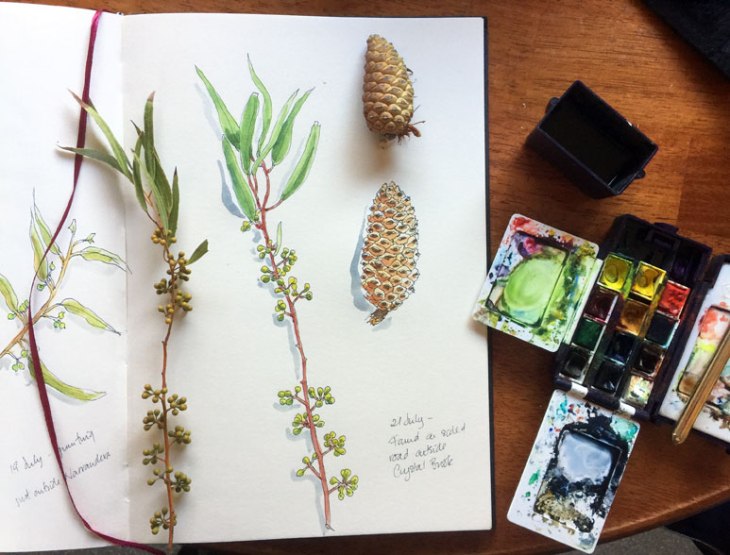
The Simpson Desert lies in the very centre of Australia, crossing the edges of South Australia, the Northern Territory and Queensland. Not easily accessible, with narrow tracks the only way to cross it, except for travellers on foot or with camels.
We have just returned from a trip along the Madigan Line, a track established in 1939 for a scientific expedition by Cecil Madigan, who travelled from West to East with camels across the Northern Simpson Desert, with a view to assessing the agricultural viability of the area. The title of the book he wrote about the the trip, ‘Crossing the Dead Heart’ gives away his feelings.
The Madigan Line is not a very clearly defined track, and because of its remoteness we decided to join a tagalong tour, to have the support of other vehicles. The danger out there of travelling alone is in the case of a breakdown or accident it could be many days before anyone else came along to offer assistance. We travelled with a convoy of nine other four-wheel drive vehicles, crossing about 900 sand dunes of varying heights, the smaller ones being about 5 metres and the highest over 70 metres, and with varying degrees of difficulty – some easily up and over, others requiring a lot more effort. Every vehicle must carry a sand flag on the front, a red flag on the top of a 3 metre stalk, so oncoming vehicles are visible as they cross the dunes. On several occasions vehicles became bogged and had to be towed out. Travel was slow due to the condition of the tracks, some days we covered about 80km in 8 hours of driving, but it gave us a chance to observe the landscape.
We met the group in Port Augusta, South Australia, and from there travelled to Woomera, up the Oodnadatta Track, to William Creek, Mount Dare (some of these places are so small there is nothing there but a roadhouse selling food and fuel) and from there to the beginning of the Madigan Line. Madigan’s camp sites were marked by small marker posts, and we camped at or close to some of them. Once we were on the Madigan Line we were bush camping, so had to carry all our food, water and fuel with us. The phone and internet connection were long gone, not to be found again till we got to Birdsville a week or so later.
The scenery changed constantly, from barren stony expanses, to the deep red sand dunes with spinifex plants, to areas with underground water where small, hardy gidgee trees and shrubs were growing. The area between each dune could vary dramatically. The most startling and beautiful surprise was the view from the top of one dune, looking down into an oasis of green – flood water had swept through the valley and the masses of seeds that lie dormant, potentially for years, had sprung to life, covering the valley with low green plants and small white, yellow and purple flowers.
Because of rain that had fallen some months before in Queensland, water had come down many of the creeks that as a rule are dry, eventually emptying into Lake Eyre, filling it in a way that only happens occasionally. This meant that some of the tracks we expected to follow were impassible, so detours had to be made, but the great advantage was seeing that part of the country green, with creeks full of water, spilling over the banks, and a wonderful array of desert flowers.
As we travelled I collected small objects and plant specimens to draw, and the other members of the group found objects for me too – some wonderful things, the pupa case of what must be an enormous moth, a camel skull (something I had been hoping to find!), a live gecko, which obligingly remained perched on the edge of my sketchbook while I drew it, as well as plants and feathers. I’m very grateful for all these! Time was always short as we had a long way to go and little time at the end of the day so I didn’t do as many drawings as I would have liked and some were a bit rushed, but at least I did manage to do some!
Once I have sorted through my photos I will do post of them too, but for now, here are the sketches – the first three were done on the way to Port Augusta, so are not from the desert, but the rest are. They were done in a Stillman and Birn A4 hardback sketchbook, and I draw straight in with fine water resistant pen, then add the watercolour.
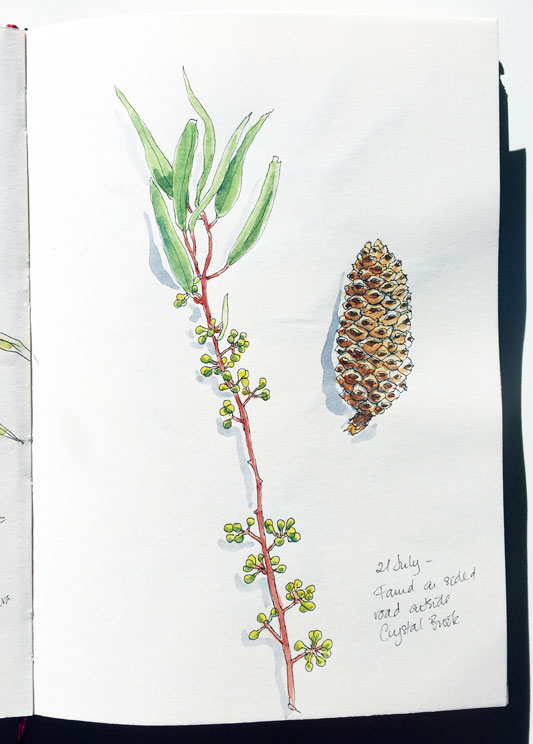





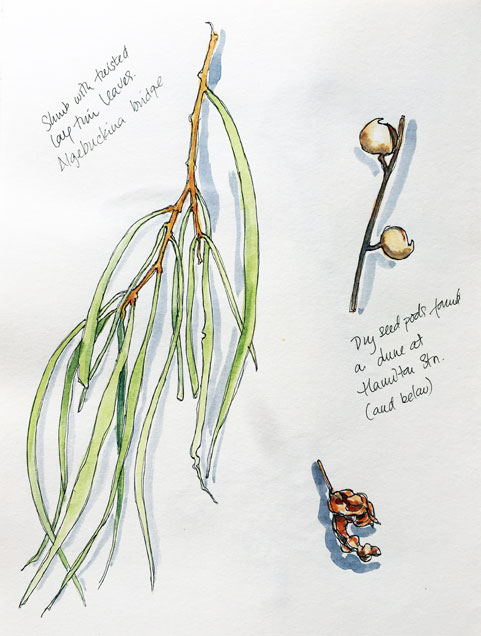
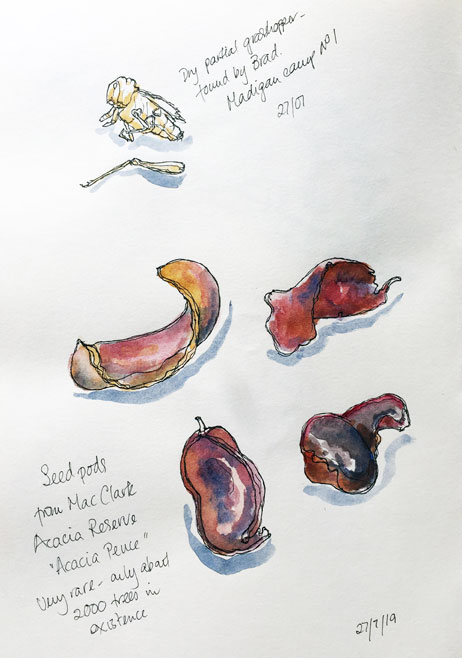




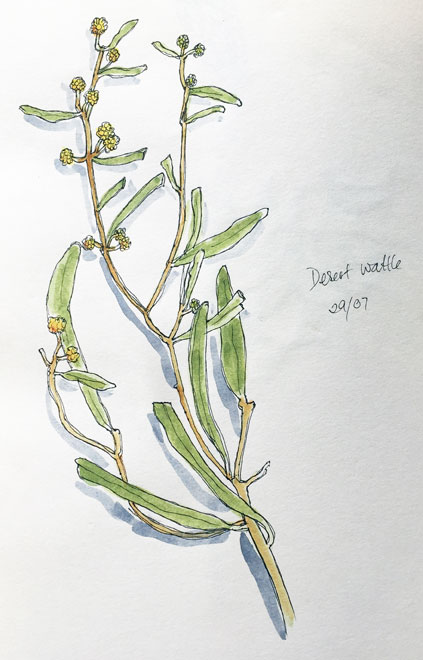


What a fascinating journey that must have been and presumably a chance to see parts of Australia that many Australians would never see. What a wonderful record you have/
LikeLiked by 1 person
I love the desert Anne, once you have been there you have to keep returning, but you are right, very few people get there. The remoteness is part of the appeal but there is something in those huge spaces that is different from anywhere else.
LikeLike
What a fabulous trip! And beautiful drawings, as ever.
LikeLiked by 1 person
Thanks Caroline, it really was a great trip, very memorable in so many ways.
LikeLike
Love the details in your drawings, Anna. Your desert trip sounds wonderous 😀
LikeLiked by 1 person
Thank you – I do love the little things! It was indeed a wondrous trip.
LikeLiked by 1 person
What a different sort of trip to a European cruise! Perhaps 2019 could go down as your Varied Year of Travel. I think I can guess which trip is the most rewarding and challenging. What a wise idea to traverse these dunes within a group. I’m sure that experiencing the very most interior regions of Australia must alter your relationship with this country. It is like you are sharing her innermost secrets – ones which most of us don’t share.
Also surprising are the vibrant greens in your studies – but you explain this as due to the earlier rains of the year penetrating deep inland. And my final thought is how wonderful that you don’t only draw these objects but can identify them and call them by their names. Not for the first time I am reminded of Beatrix Potter and her scientific observations and drawings.
LikeLiked by 1 person
It certainly has been a varied travel year, I did love the snowy extremes of the Arctic Circle but this couldn’t really be more different! Because of the difficulty for most people to get to the very heart of Australia it does have a special, secret quality. I know it is a privilege that not many people can (or for that matter want to!) experience, which adds to the sense of it being something special. The green elements are surprising, but not rare, some areas have vibrant green tough plants in profusion. I love the flowers that emerge whenever they have access to water. Finding their names adds to the satisfaction for me – there are still some I need to check! My next post will be photos, so that should add to clarifying just what it is like out there.
LikeLiked by 1 person
Your needing to find the names for your own satisfaction reminds me of myself always needing to find out the name of the maiko and geiko I drew. I totally understand. I look forward to the photos. In another way that your trip is so different, by the way, to the Arctic Circle is that on a cruise you have your every need taken care of, contrary to this trip where you need to be razor sharp in wits and expertise in self-sufficiency.
LikeLiked by 1 person
Finding out the names somehow anchors the plants and makes them real, gives them a character in the same way as knowing just who your geiko and maiko were.
You are right about the cruise being a cocoon of being looked after, this was truly very different, but being in a tagalong we did have the support of a leader and mechanic (who thankfully we did not need to call on) as well as the community of other people with us which gave us a level of support neither of us would have been happy to do without! But yes, self-sufficiency was the order of the day!
LikeLiked by 1 person
Fabulous adventure and record 🌺
LikeLiked by 1 person
Thank you! It was a special trip.
LikeLiked by 1 person
Anna, thank you for sharing the heart of Australia with us. I admit I’m very curious about this mysterious area of the world and enjoy reading and seeing all that you experienced. I always love seeing your botanical drawings with a side of bones! You continue to inspire me in so many ways. I look forward to your next post.
LikeLiked by 1 person
It is a mysterious part of the world, the inaccessibility adds to that sense I think. I have more bones to draw – a camel’s vertebra, a cow’s skull and my camel skull too, so I’m looking forward to getting stuck into those! We didn’t see any live camels sadly, something we were hoping for, but I think they are very clever at keeping hidden. I’m still sorting my photos, but I will post some them next! Thanks so much Cathe!
LikeLike
I have never been that far into the Centre, but have almost touched the edges of it ~ Broken Hill and Menindee, the Nullarbor, the Flinders Ranges. I love the big sky and the sense of an ancient, vast land. But there are also the things that live in these impossible places, and you have captured them so well in your sketch book. I am so looking forward to your photos.
LikeLiked by 1 person
You have got very close to where we were – its just that final push into the most remote parts. I love it there too, and constantly ask myself just what it is. When I saw the first lot of spinifex on a red dune I felt a thrill of euphoria, it was so symbolic of the Simpson Desert. There are so many things – animals, plants, reptiles – that live there, it is not the classic barren desert at all in most parts. The big skies, endless horizon, and as you say the ancientness of this place are all elements that add to what it is.
The photos are still being sorted, hopefully I will get some up before the end of the week!
LikeLiked by 1 person
I have had annual trips to Menindee as part of the group recording and painting the plants collected there on the Bourke and Wills expedition. As you are whizzing by in the car it appears to be just saltbush scrub, but once you get out and explore you see that there are so many delights, which you know from your spines country.
LikeLiked by 1 person
Its amazing how much there is to see once you do get out and start to walk. One of the things that I find endlessly fascinating is the array of footprints and marks made by the creatures, from tiny lizards and insects to camels and – sadly – cats.
LikeLiked by 1 person
These are so beautiful. I am too lazy to take paint out with me!
LikeLiked by 1 person
My paint set is really compact – its a Winsor and Newton travel set and folds up to a small box, but opens out with little palettes and 12 half pans of paint, a tiny water bottle and the lid becomes a water holder that clips on the front. With that and a couple of travel brushes (a small one is included in the paint box) I’m set. I find the colour is essential for what I do, to capture reasonable accuracy of the plants, and it is fun just splashing it on at the end! This is the only time I ever use watercolour so they don’t really get used at home, unless I am catching up on unfinished work!
LikeLike
Your drawings are beautiful. ^^ Glad I found your blog. Your creativity is inspiring.
LikeLike
Thank you so much! Doing sketching while travelling helps keep the memories alive I find.
LikeLiked by 1 person
I loved reading about your trip and always seeing your drawings. Our lives are so different but I feel a connection through a certain perspective of the world we see. Mine is much more limited than yours due to disability so my travels are not extensive. But I look and see where ever I am (even when in my bed 🙂 ). Thank you for sharing all that you do.
LikeLiked by 1 person
It’s interesting isn’t it that lives can be so different but still intersect through a shared concept of the world. I certainly empathise with your work, I always enjoy seeing it and looking inside what you have put down.
By the way, I think my comments on your blog posts have been going into spam – I recently updated this blog to get rid of the ads, and since then a lot of my comments have disappeared into spam! I discovered this when I got no reply from an artist I follow who always replies, then I found the comment had disappeared from her post, and she found it in spam. I don’t know how many times this has happened, I discovered another recently, and I think it has been happening on yours too. I expect my last one may have been already emptied out of spam so I will go back and comment again, and hopefully either it will stay out of spam or you can retrieve it!
LikeLike
I loved reading about your adventure! As for those lovely sketches, I’m seeing an illustrated book…
When you think of how inaccessible the desert is, you would bring it to life for so many people who could never get there but will get to see all of its rich life.
LikeLiked by 1 person
Thank you so much Patsy! The drawings often go on to be reference for other projects, so no doubt these will too. The desert really is extraordinary, and as you say very few people have the opportunity to get there, so if my posts help people get a bit of a feel for it, that makes me happy!
LikeLike